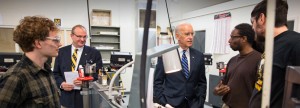Missouri met one of the first major milestones for implementing WIOA. Missouri’s core workforce partners executed the official state-level MOU showing the commitment to improve collaboration at the state and local levels. This is important to workforce professionals at the local level as the MOU provides the tools to increase collaboration and braid resources locally, according to Amy Sublett, Director for the Missouri Division of Workforce Development.
 The official purpose of the MOU is to establish a collaborative framework encouraging cooperation, collaboration, communication, policy and technical guidance and governance to assist the efficient and effective participation in the WIOA implementation in Missouri. The partners will collaborate to identify effective services for efficient, consistent customer service delivery. The MOU includes a disclaimer that partners continue to have statutory responsibilities relating to the administration of their respective programs outside of, and not contained in, WIOA.
The official purpose of the MOU is to establish a collaborative framework encouraging cooperation, collaboration, communication, policy and technical guidance and governance to assist the efficient and effective participation in the WIOA implementation in Missouri. The partners will collaborate to identify effective services for efficient, consistent customer service delivery. The MOU includes a disclaimer that partners continue to have statutory responsibilities relating to the administration of their respective programs outside of, and not contained in, WIOA.
In Missouri, the core partners representing these programs formed a steering team at the state level to support efforts taking place at the local level. Representatives from the agencies include Vocational Rehabilitation, Rehabilitation Services for the Blind, Workforce Development, Employment Security, Temporary Assistance for Needy Families and Adult Education and Literacy. While TANF is not specifically mentioned as a core partner in WIOA, Missouri opted to include TANF in this tier in order to gain ground in integration and to achieve the improvements sought in the recently-enacted Senate Bill 24.
Altogether, the MOU, Missouri’s WIOA Implementation Steering Committee, and four new state-level workgroups, are all designed to provide guidance to the staff of Missouri’s local Workforce Development Boards to move forward on WIOA implementation on the ground level. The workgroups include Administration, Service Design and Delivery, Employer Engagement, and Technology, Data, and Outcomes.
- Administrative
- Core partner identification and designation
- Core Partners Interagency Agreement (Local MOUs)
- Agreements and MOUs with other Agencies/Institutions
- Confidentiality Policies
- Cost Allocation
- Resource Sharing
- Cross Training and Technical Assistance
- Region and Local Area Designations (mapping)
- Equal Opportunity
- State/local planning
- Labor Market Information
- Integrated policies and guidance
- Service Design and Delivery
- Referral and follow-up
- Common intake and enrollment
- Assessment and Evaluation
- Internships, Apprenticeships, Trial Work Experience, OJT
- Education and Training
- Programmatic Requirements
- Transition and Youth
- Assistive Technology Services
- Products and Services for all customers (including online tools)
- Employer Engagement
- Services to Employers
- Sector Strategies/Career Pathways
- Technology, Data, and Outcomes
- I.T. System for Core Programs
- Confidentiality
- Data Sharing
- Data Fields
- Data Collection Points
- Common Measures
- Closure and Exit
- Performance Verification






 In the next ten to fifteen years, EDOs will be responding to changes and shifts that cannot be quantified today. While it is impossible to know with certainty what these disruptions will be, at a macro level there are existing trends – demographics, technology expansion, shifting global roles, and climate change – that act as signals for what may happen.
In the next ten to fifteen years, EDOs will be responding to changes and shifts that cannot be quantified today. While it is impossible to know with certainty what these disruptions will be, at a macro level there are existing trends – demographics, technology expansion, shifting global roles, and climate change – that act as signals for what may happen.